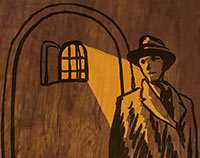COMMENT OF THE DAY: HOW TO WORK AROUND THE HOUSTON HEIGHTS DRY ZONE  “Can someone explain to a non native Houstonian how this ‘private club’ thing works? So you can’t sell alcohol in some areas, but you can if you’re a ‘private club’? So what’s to stop anyone that wants to open any regular type of place that sells booze to call themselves a private club?” [Cody, commenting on Putting the Finishing Typefaces on the Heights General Store] Illustration: Lulu
“Can someone explain to a non native Houstonian how this ‘private club’ thing works? So you can’t sell alcohol in some areas, but you can if you’re a ‘private club’? So what’s to stop anyone that wants to open any regular type of place that sells booze to call themselves a private club?” [Cody, commenting on Putting the Finishing Typefaces on the Heights General Store] Illustration: Lulu





Many years ago, when ShadyHeightster lived in Dallas, there were (and still are) only a few precincts in that city that are wet. So most restaurants in dry areas operated under the “private club” aegis and charged you a yearly membership fee of like $5 or $10 to drink there. You got a little picky as to how many of these places you “joined”. Chains like Chili’s and Red Lobster even did this.
Today I don’t see these private clubs in the Heights charging for membership. I do think there is a regulation stipulating that a certain percentage of revenues must come from food sales. This is borne out that most of these clubs are also restaurants and not just night clubs. Keeps the bars down on Washington and out of the ‘hood.
I’m not an expert on this topic—hopefully someone who knows more will chime in—but I don’t think it can be described as an “easy loophole.†Joining the club is easy for consumers, so as a restaurant-goer, you barely notice the difference. But my understanding is that the restaurant has to have some founding members who put up the initial cost of stocking the bar, and further alcohol can only be purchased with proceeds of alcohol sold, which calls for some pretty complicated accounting to keep the food and alcohol sales separate. Obviously there’s money in it despite all this or people wouldn’t do it, but it’s not as simple as the commenters have made it sound and it’s definitely not something every business owner wants to take on.
Just mho, I think people may just be implying that it’s easy because they are holding it in relation to the money that could potentially be made due to the changing Heights demo. All restaurants/bars have myriad challenges, so any such hurdle could cause an unwary investor or restaurateur to wobble on the razor’s edge. However, from the recent developments I’ve seen, I think most of these new projects are well-backed and can pay to play the game.
http://www.tabc.state.tx.us/forms/compliance/audit/c-304.pdf
Lots of red tape with a private club license. You are required to serve food. You cannot just get people boozed up. The above posts are correct about other requirements.
The Heights has been saved by the dry areas. But for the designation, there would be dive bars and ice houses dotting the neighborhood that would have been a major impediment to the comeback the area has seen. Also, moving forward, the dry areas make sure that anyone coming into the area who wants to serve alcohol is serious about what they are doing and committed to the neighborhood.
The most simple explanation is the cost of the permit. Not sure of the costs but I believe the Private Club license is many times more expensive than a regular liquor license.
Soon we will have more private clubs around 19th than we have bars on White Oak.
Political patronage.
It is a continuation of the power of the Baptist Belt that Houston sits in. The area did not want the sins that came with liquor but there were exceptions, as is the case with most things religious. Hard liqour was the real scourge, hence a smattering of ice houses and places like the SPJST Lodge on Beall. The churches and clubs wanted to be able sip on a cold one while dancing and playing bingo so the sale of beer was OK as long as you were a member of the organization, incidentally most of these organizations also were pretty clear on white patrons only. Additionally, all of these places were happy to sell set-ups for those tht brought their own booze. Cheers!
There used to be ice houses scattered throughout the Heights area and I believe Adrian Garcia was instrumental in closing them down. Sorry, I don’t recall whether or not Gabriel Vazquez who preceded Mr. Garcia on city council was part of the clean-up.
I was doing some research today, and came across a newspaper clipping that might shed some light on this. The reason why some parts of The Heights are dry, and always will be, has to do with a quirk in Houston’s History. In 1912, The Heights, then a separate municipality from Houston, voted to go dry under Local Control laws set up by the state. However, after Repeal of national Prohibition, the Texas Attorney General ruled in 1936 that the Heights, now part of Houston, was still subject to the dry laws enacted by the voters. Per the AG, the only mechanism for those parts of the heights to go Wet was for The Heights to become an independent municipality again and vote itself Wet, or a state Constitutional amendment.